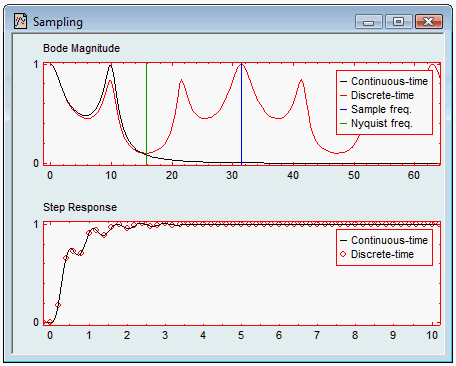Sysquake Pro – Table of Contents
Sysquake for LaTeX – Table of Contents
sampling.sq
Effect of sampling a signal with different conversion methods
Automatic control and signal processing is usually performed using digital computers, microcontrollers or programmable logic. This offers much more flexibility than analog devices. For good results, sampling must respect the Shannon theorem, which states that sampling should be performed at at least twice the frequency of the bandwidth of the sampled signal; otherwise, aliasing (high-frequency signal components appearing at lower frequencies) occurs. When a digital computer is connected to a system, the output is usually sampled by picking the measured values at regular discrete times, and the input is usually applied at the same times and kept constant until the next sample time; this operation is called a zero-order hold.
Another operation consists in converting a continuous-time
transfer function (describing the frequency filtering of a system between its
input and its output) to a discrete-time transfer function. When the transfer
function corresponds to a filter or a controller, the zero-order hold method
is usually not used, because there is no such hold; the problem is different,
and actually it has no exact solution. Usually, the

First contact
When you open sampling.sq from Sysquake (menu File/Open), two figures are
displayed: the frequency response magnitude and the step response
Figures
Bode Magnitude
The magnitude of the continuous-time transfer function is displayed in black, and the magnitude of the discrete-time transfer function is displayed in red. The Nyquist frequency and the sampling frequency, which can be manipulated, are displayed as green and blue vertical lines, respectively.
Bode Phase
The phase of the continuous-time transfer function is displayed in black, and the phase of the discrete-time transfer function is displayed in red. The Nyquist frequency and the sampling frequency, which can be manipulated, are displayed as green and blue vertical lines, respectively.
Step Response
The step response of the continuous-time transfer function is displayed in black, and the samples of the step response of the discrete-time transfer function are displayed as red circles. The samples can be dragged to the right or to the left to change the sampling period.
Continuous-Time Poles
The poles of the continuous-time transfer function are displayed as crosses in the complex plane of the Laplace transform. The stability region (to the left of the imaginary axis) is shown in yellow.
Discrete-Time Poles
The poles of the discrete-time transfer function are displayed as crosses in the complex plane of the z transform. The image of the stability region in the complex plane of the Laplace transform is shown in yellow; it depends on the method used for the conversion to discrete time.
Settings
Zero-Order Hold
The discrete-time transfer function is obtained by adding a zero-order hold element before the transfer function and sampling the result.
Tustin
The discrete-time transfer function is obtained by performing the following substitution in the continuous-time transfer function:
where
Back Rect
The discrete-time transfer function is obtained by performing the following substitution in the continuous-time transfer function:
For Rect
The discrete-time transfer function is obtained by performing the following substitution in the continuous-time transfer function:
Pole/Zero Matching
The discrete-time transfer function is obtained by replacing the poles
and zeros
Continuous-Time TF
The continuous-time transfer function can be entered in a dialog box as two vectors containing the coefficients of the numerator and denominator, respectively, highest power first.
Sampling Period
A precise value can be entered in a dialog box for the sampling period.